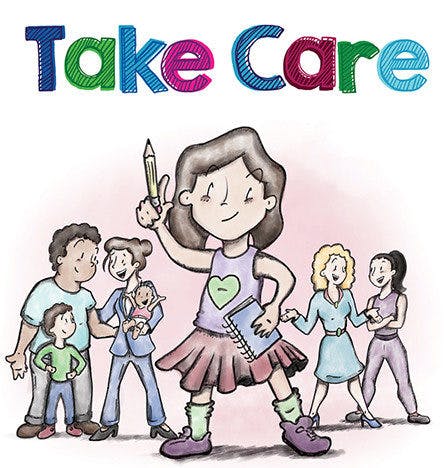What happens when a child discovers that adults at her parent’s workplace can sometimes treat each other unkindly?
Welcome to the real world, little girl. That’s what the cynic in you might be thinking.
Perhaps that’s because so many of us have a mindset of it is what it is when it comes to tolerating, if not outright accepting — or even expecting! — the inhumane ways in which colleagues interact with each other.
Except, this is not how many of us were raised. Yet sometime between childhood and career-hood, we seem to lose touch with lessons we learned as kids about caring for others. It’s as if we need a children’s book to remind us that the workplace can — and should — be a caring place.
And, in fact, we now have that book. In Take Care, a girl named Louise learns that a rule in her class — ”take care of yourself and each other” — is not being followed at her mom’s workplace. What happens next ends up reminding her mom about some valuable life lessons.
Take Care is written by Laura Hamill, chief people officer and chief science officer at Limeade, an employee experience company, and Jolene Cramer, Limeade’s senior director of integrated marketing. TLNT recently spoke with Laura about why she wrote her new book and some of its lessons — for kids and for adults.
TLNT: What made you decide to write a children’s book?
Laura: We recently did some research on the science of care, which speaks to the well-supported idea that the more that organizations encourage and support their employees, the better off those organizations. After Jolene saw me give a presentation about this, she suggested that we write a children’s book to reinforce these concepts for kids. We wanted to really show that the things we learn as kids about caring for other people are important in the workplace, too.

It almost feels at times like this is an adult book disguised as a children’s book.
The audience is both. After all, parents would be reading this to their kids. Really, this book is based on purity and intent around wanting the best for kids. Jolene has two little kids. I have a son who is 20 and a daughter who is 16. We both want our children to have positive experiences when they go to work. We don’t want toxic environments for them.
Kids inherently understand the value of caring for each other. Why do we later in life go to work and basically suffer from amnesia when it comes to practicing such life lessons?
You know, not long ago, I was giving a presentation to C-suite leaders in a big company about the importance of caring for people. The COO, an older gentleman, was there. He told me that he really enjoyed and was excited by the presentation, but he said, “This is such a foreign concept to me. Never in my whole career has someone treated me at work like a human being. He’d been working for who knows how long, and he’s always had an expectation that people would be a certain way.
That tells you that we need to change our model of what work is. We really do need to focus more on treating people like human beings.
Right, but where do we go wrong? Why don’t we treat each other more humanely?
In my first job, back in the dotcom era, my office was across from a conference room where people got yelled at. We called it the punishment room. Someone actually threw a chair there!
I think we get to a place of throwing chairs, or doing lesser things that don’t demonstrate care, through lots of people practices that don’t necessarily support the notion of caring. Like command-and-control leadership. It wasn’t a good model for managing in manufacturing years ago, and it still isn’t. Yet these practices persist. We expect people to be engaged and creative these days, but we treat people in old-school ways.
However, I have seen a lot of evolution over time in companies. Years ago, I remember we would go and speak to organizations about caring about employees as human beings. People said that was ridiculous! Good luck with that, they said. And now it’s so refreshing that companies are increasingly embracing the idea that how you treat people is fundamental to business success.
Thought it can still take a while for some to come around. I was meeting with a prospect for a presentation on burnout. I gave him a slide deck for the presentation. But when he saw slides that showed the organization’s responsibility for burnout, he asked, “Can we pull that out? We don’t want to talk about the role that we play in burnout.” So there’s still a lot of inertia.
In the book, a child witnesses her mom losing her temper at work. She’s shocked that her own parent would behave that way.
Yes, and the irony is that we behave that way oftentimes not because we don’t care but because we are frustrated and care so much. Many people are very invested in work. And you want people to be invested, and you want healthy conflict. It’s just that there are better ways to have conflict. And when you do make a mistake and lash out at work, the book shows the importance of saying you’re sorry as a way to demonstrate you care about others.
It occurred to me while reading your book that the notion of caring is especially important for young boys to learn. It seems like we raise boys in ways that encourage them not to talk about such emotions and to even view caring as a weakness in business.
Yes, our society can have rigid gender roles, which can be paralyzing. It’s important for boys to embrace caring, to show them that caring is natural and human and not gender-specific.
Meanwhile, women in leadership roles are also in a difficult situation. My style has always been to be a people kind of person, but I felt like early in my career, I had to stifle that. I couldn’t be more relational in my style. Eventually, I got to a point where, you know what? Screw that, I thought. I will be me. Luckily, I’ve been working at places that have embraced that.
What do you think are some common misconceptions that children have about work?
Kids will latch onto things that really are not the most fundamental aspects of work, like snacks in the office or desks going up and down. Meanwhile, my kids have teased me about how happy people are at my work. They like it and make fun of it at same time. “Everyone is so nice to each other!” they say. But part of the point here is that we as parents are sending messages to our children by how we talk about work at home.

Setting expectations about work early on with kids helps create a model for them. It’s important for parents to feel positive and excited about work. Of course, we also don’t want to create falsehoods that work is always this fun place, but it is nonetheless important to be cognizant that out kids are taking in how we view work.
For example, I grew up in a log cabin on 60 acres of land without electricity from 4th grade until college.
Wait, what? No electricity? Umm…
I know, right! Anyway, my dad was a carpenter, and he always had bad experiences with work. He never kept a job for very long. He was always talking about how much he hated “the man.” I felt like his experience was awful, but in some ways it got me interested in becoming an organizational psychologist.
It didn’t make sense to me then how you can hate the people you work with. That’s not what I wanted for my work life. I want it to be really good. So that was the root of how I got interested in creating workplaces where people treat each other like humans.
This interview has been edited and adapted for publication. Article image is taken from book cover, the illustration of which is by Brian Russo.
